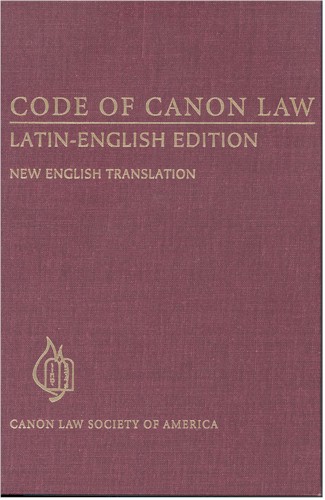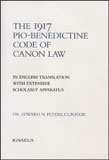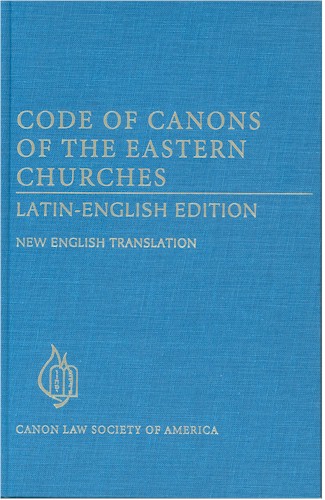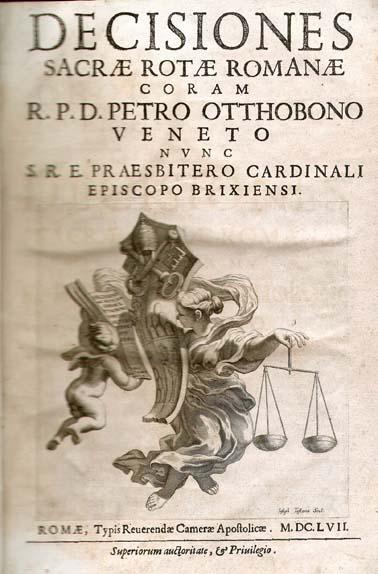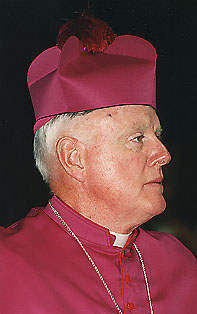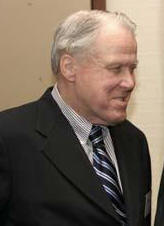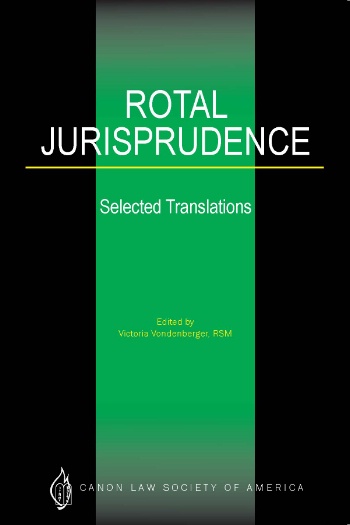|
To work for the proper implementation of canon law is to play an extraordinarily constructive role in continuing the redemptive mission of Christ. Pope John Paul II |
|
|
|
|
Resolution 1152 x 864 |
Updated 7 jan 2013 |
Resources on The Roman Rota |
|
Overview |
The Roman Rota is the Catholic Church's highest judicial court.
|
|
The Law |
1983 CIC 1443. Tribunal ordinarium a Romano Pontifice constitutum appellationibus recipiendis est Rota Romana.
• Eng. trans., 1983 CIC 1443. The Roman Rota is the ordinary tribunal established by the Roman Pontiff to receive appeals.
1983 CIC 1444. § 1. Rota Romana iudicat: 1° in secunda instantia, causas quae ab ordinariis tribunalibus primae instantiae diiudicatae fuerint et ad Sanctam Sedem per appellationem legitimam deferantur; 2° in tertia vel ulteriore instantia, causas ab ipsa Rota Romana et ab aliis quibusvis tribunalibus iam cognitas, nisi res iudicata habeatur. § 2. Hoc tribunal iudicat etiam in prima instantia causas de quibus in can. 1405 § 3, aliasve quas Romanus Pontifex sive motu proprio, sive ad instantiam partium ad suum tribunal advocaverit et Rotae Romanae commiserit; easque, nisi aliud cautum sit in commissi muneris rescripto, ipsa Rota iudicat etiam in secunda et ulteriore instantia.
• Eng. trans., 1983 CIC 1444. § 1. The Roman Rota judges: 1º in second instance, cases which have been adjudicated by the ordinary tribunals of first instance and brought before the Holy See through legitimate appeal; 2º in third or further instance, cases which the Roman Rota or any other tribunals have already adjudicated unless the matter is a res iudicata. § 2. This tribunal also judges in first instance the cases mentioned in can. 1405 § 3 and others which the Roman Pontiff, either motu proprio or at the request of the parties, has called to his own tribunal and entrusted to the Roman Rota; unless the rescript entrusting the function provides otherwise, the Rota also judges these cases in second and further instance.
John Paul II, ap. con. Pastor bonus (28 iun 1988), Acta Apostolicae Sedis 80 (1988) 841-912, artt. 126-130, on-line PDF here, Eng. trans. available in Canon Law Society of America, Code of Canon Law, Latin-English Edition, New English Translation (Canon Law Society of America, 1999) 679-734, at 721-722, and on-line here.
Benedict XVI, m.p. Quaerit semper (30 aug 2011), Acta Apostolicae Sedis 103 (2011) 569-571, on-line PDF here, Eng. trans. on-line here, establishing a new office in the Rota for hearing ratum cases and nullity of ordination.
See also Sacra Romana Rota, Normae S. Romanae Rotae Tribunalis (per Ewers, 16 ian. 1982), Acta Apostolicae Sedis 74 (1982) 490-517, on-line PDF here, Eng. trans. in Canon Law Digest 10: 219-248.
See also Tribunal Apostolicum Sacrae Romanae Rotae, Decisiones seu Sententiae (Typis Polyglottis Vaticanis / Libreria Editrice Vaticana, 1912 to present) publishing annually selected Rotal sentences issued from 1909 on.
|
|
Prelate Auditors of the Roman Rota
|
Usually there are about 20 Prelate Auditors (or judges) serving on the Roman Rota.
The name of the Dean is placed in bold.
Italian Auditors listed in Red. Native English
speakers are marked
USA:
Source: Cittá del Vaticano, Annuario Pontificio, "Tribunale della Rota Romano"
|
|
"If one takes a given volume of the Rota decisions and reads consecutively all of the decisions on a given caput, it does not take long to discover that the Rota frequently reverses itself. These reversals are generally due to different interpretations of the facts. At times, however, the reversals are due to different interpretations of the law. The conclusion is that the law, as expounded by the Rota in a given decision, especially on an abstruse point, is not necessarily above all controversy." J. Chatham, "Sources and their use in the preparation of briefs and sentences" The Jurist 20 (1960) 84-98, at 89.
Links on-site
Links off-site
Rev. Rhode's
Msgr. Cormac Burke retired Rotal auditor
Wiki
Wiki Tribunale dellaRota Romana
|
|
|
Historical Note on the Roman Rota
Another historical overview at New Advent (the original Catholic Encyclopedia): "Sacra Romana Rota" [English]
For a brief history of the famous Spanish Rota at Madrid, reconstituted in 1947, see Anon, "The Establishment of the Spanish Rota" The Jurist 7 (1947) 427-436; for brief comments on the Spanish and "Polish Rota", see E. Egan, “Appeal in marriage nullity cases: two centuries of experiment and reform”, Canon Law Society of America Proceedings 43 (1981) 132-144.
|
From the earliest days of the Apostolic Chancery there were chancellors (later vice-chancellors) known as l’auditores contradictorum and cappellani. To these were assigned, at first case-by-case but then on a stable basis, investigations of cases (auditores causarum curiae domini papae) although Pope Innocent III withheld from them the power of pronouncing final sentence. Under Pope Innocent IV and the First Council of Lyon (1245) these chaplains developed into a stable tribunal; John XXII assigned to this group a particular center and, in 1331 with the constitution Ratio iuris, he organized it according to a special rule. The name “Rota” probably derives from the round room in which the Auditors met to hear cases. Pope Sixtus IV (1472) originally set the number of Chaplain Auditors at twelve. Pope Benedict XIV definitively set out the competence of the tribunal in his constitution Iustitiae et pacis in 1747. Beginning with Pope Gregory XVI (1834) the Rota served as an appellate tribunal for the Papal States, while cases pertaining to the ecclesiastical forum typically went before Congregations.
In 1870 the activity of the Roman Rota essentially ceased [in the turmoil following the Italian Revolution], but with his constitution Sapienti consilio (29 June 1908) Pope St. Pius X reconstituted it (ASS 41 [1908] 425-440, at 435). This document was accompanied by the Lex propria S. R. Rotae et Signaturae Apostolicae (ASS 41 [1908] 440-461) and both were soon (4 August 1910) supplemented by the Regulae servandae apud S. R. Rotae Tribunal (AAS 2 [1910] 783-850). Pope Pius XI amended these norms on 29 July 1934 (AAS 26 [1934] 449-491). Further amended norms were approved on 16 January 1982 (AAS 74 [1982] 490-517, Eng. CLD 10: 219-248). The current norms were approved by Pope John Paul II on 18 April 1994 and went into effect October 1 of that year (AAS 86 [1994] 508-540).
The appointment of auditors has always been reserved to the pope, but certain nations have the right to nominate auditors; thus Spain may propose two auditors, and Germany and France one each. [The Italian sees of] Bologna, Milan, Venice, Ferrara, and Perugia each also have the privilege of nominating auditors. All must nominees must be doctores iuris famosi and be distinguished for prudence and integrity of life.
The Rota adjudicates cases in a turnus (panel) of three Auditors or the ones who see everything [submitted in a case]. Essentially the Rota is today an appellate Tribunal (1983 CIC 1444) and adjudicates: a) in second instance, cases decided by ordinary tribunals at the trial level that are sent to the Holy See by legitimate appeal; b) in third and further instances, cases already treated, [and arising] by appeal within the Rota or coming from other another ecclesiastical appellate tribunal. Furthermore, it can adjudicate in first instance cases expressly reserved to it according to the tenor of 1983 CIC 1405 § 3 and those which, upon being called by the Roman Pontiff to himself (either on his own or at the request of a party), are sent to it by the Supreme Pontiff. The Rota is also the Tribunal of appeal for the Ecclesiastical Tribunal of the Vatican City State (John Paul II, m.p. Quo civium, 21 Nov. 1987, art. 7).
Cittá del Vaticano, Annuario Pontificio (any recent year), Peters' trans, text slightly amended.
|
|
Selected studies on the Roman Rota
|
|
|
English Translations of Rotal Sentences
|
CUA published translations of the 11 Rotal sentences that served as sources for 1983 CIC 1095, 1° in The Jurist 54 (1994).
For the last several years, Msgr. Cormac Burke, Rotal auditor from 1986 to 1999, has made English translations of several of his sentences available, in whole or in part, on his website. Some translations into Spanish and French are also available there.
In 2009, I published a translation of coram Filipiak, 23 martii 1956, SRRD 48 (1956) 255-258, here.
Recently released is: V. Vondenberger, ed., Rotal Jurisprudence: Selected Translations (Canon Law Society of America, 2011) 301 pp. Order it here. Review: J. Scheib, The Jurist 72 (2012) 320-321. |
